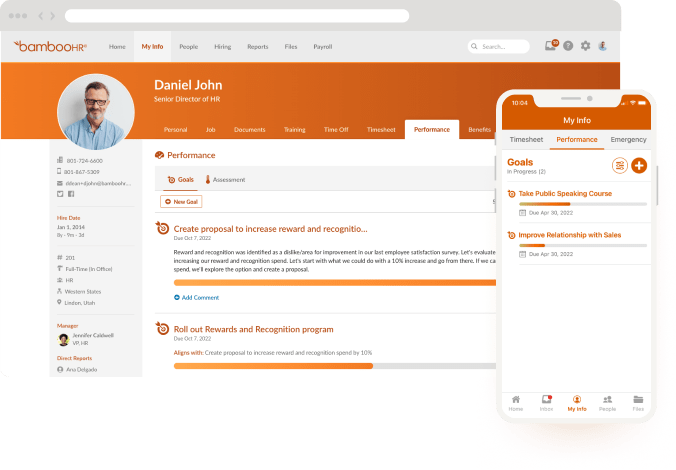
The Definitive Guide to Performance Management
Not Just Performance Reviews
If your idea of performance management is only conducting annual employee performance reviews, you may be missing out on effective ways to align employee and company goals. By swapping out infrequent check-ins with a plan for ongoing communication around performance, you can create a clear path to success that defines objectives, expectations, and feedback methods.
Performance management is a holistic strategy that impacts your company policies, culture, and outcomes. It lets employees know if they’re on the right track, informs about why their work matters, and shows how they’re moving the business forward. Performance management also gives employees answers to questions like, “Am I good at my job?” “Am I important?” and “Am I easily replaceable?” so they aren’t left wondering … and possibly leaving for another opportunity.
The State of Performance Management Today


Organizations are recognizing their shortcomings, too.
Only 2% of companies believe their performance management approach delivers exceptional value.
MERCER’S 2019 GLOBAL PERFORMANCE MANAGEMENT STUDY
And an HR Institute Research Report found that only 27% of HR professionals say their managers are skilled at overall performance management.
The Foundational Elements of Performance Management

Leadership
It’s said that people don’t quit companies; they quit bosses
As a result, organizations must better equip their leaders to manage performance. Start by offering ongoing training on topics like effective communication, motivation, recognition, and coaching. By consistently upskilling managers, they’ll be better equipped to tap into the strengths of each employee.
If an employee believes they’re not being treated fairly or equally, they’ll be more likely to slack off or leave.
- It’s imperative that leaders manage and measure performance consistently.
- Training on spotting and overcoming their own unconscious biases
- Remove bias and subjectivity from reviews with double-blind assessments

Communication
Organizations can prevent or remedy many performance problems
According to the Society for Human Resource Management (SHRM), organizations can prevent or remedy many performance problems with two-way conversations between managers and employees. Each side should have a complete understanding of what output is required, when it is required, and how it should be delivered. This starts with having clear expectations and goals established, which will serve as the groundwork for feedback as well as transparency on company decisions.



Incentives and Compensation
This is not just salary and bonuses
What other value does your total
compensation package provide? Company
perks? What is your compensation strategy?
Salary is only one piece of the puzzle. You don’t want people to stay only for the pay—otherwise you retain the wrong people for the wrong reasons and are unlikely to meet expected performance outcomes.
Company Culture
There is no one-size-fits-all answer for creating and implementing a company culture
Companies known for engaged employees, like Google, Meta, Nike, and Netflix, have several things in common. According to a Gallup survey, these organizations use their culture and values to guide business decisions. Instead of being hollow words, culture and values are put into action every day. These companies also focus on wellbeing and are willing to adapt as their workplaces change. They acknowledge that an employee is a whole person, especially with remote and hybrid arrangements blurring the lines between work and home in many industries.


Creating Your Performance Management Strategy

Set goals

To gain the best level of understanding and commitment, the goal-setting process should include both the manager and the employee. Managers will best understand the company’s goals and how employee goals can tie into them. And employees will have valuable insights on whether expectations are achievable. Goals should be documented but flexible if conditions change that would impact achievement.
What does high performance look like in your organization and how do you define that? How does performance management help your employees grow their careers? Organizations should provide managers with clear definitions of behaviors, skills, and other performance factors to better assess employees. If guidelines aren’t set, organizations risk bias, such as proximity bias, or even personal bias, where managers allow their personal feelings about an employee to impact their rating process.

Review performance


Create a plan for performance improvement

Once you’ve measured the employee’s performance against the benchmarks you’ve set, you can implement changes based on what’s needed. For example, an employee may need more training, better time management strategies, or a discipline process. It may also be possible that the goals and objects that were set need to be adjusted due to new information or circumstances.
Performance improvement plans should be clearly stated, including a description of the performance gap, a plan of action, and potential consequences if the employee’s performance doesn’t improve.
The Role of Technology
Technology can be the answer.
The State of Performance Management 2021 research report found that three-quarters of organizations use technology to support performance management, yet only 29% of HR professionals say their organizations have performance management processes that are technology-driven to a high degree.
Another of the performance management trends identified in the Forbes article is using real-time performance data. To remain competitive in a talent shortage, organizations need to boost their employee experience with data-driven decisions that optimize performance, motivation, and development.

Consider what tech and tools you’re using to help support your leadership and employee performance management. How can technology help support your leadership to manage performance more effectively and consistently? Does your organization already have an HRIS with performance management tools included? Organizations are most likely to use performance management tools bundled into HR information systems.
When defining your tech stack, here are some useful tools and capabilities your company should consider when looking to improve performance management.
Reporting

360-Degree Structured Feedback

Shared Goals

Conclusion

Performance management is more than just holding boring annual performance reviews. It’s about caring for and growing people and leaders that support the business. Good performance management is built through leadership, communication, and useful tech that can help you grow and retain engaged employees.
Ready to take your performance management to the next level? Learn more about BambooHR Performance Management software.